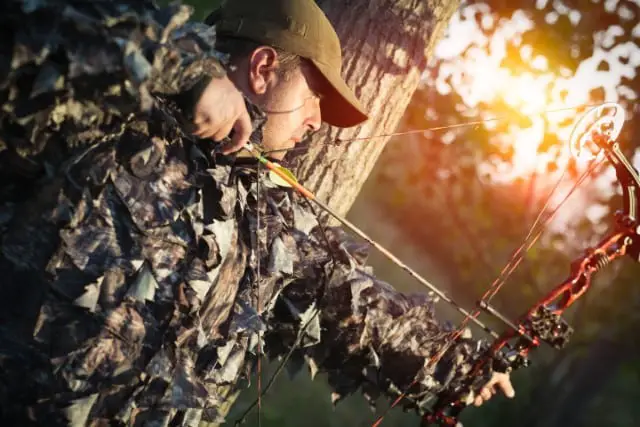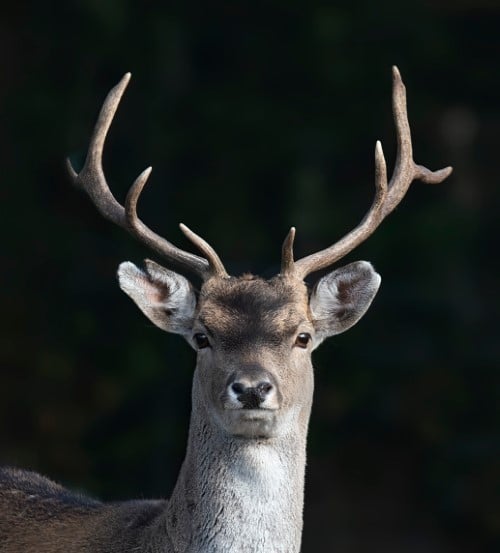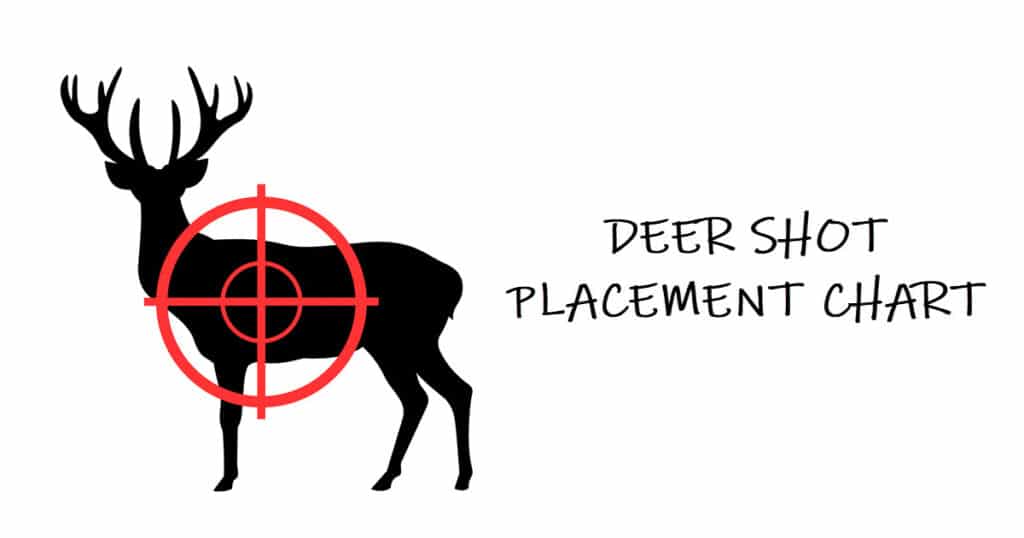Shooting a deer the wrong way can cause undue pain and suffering to the animal, and it may mean you spend a long time tracking the injured deer through the woods (and have a long and difficult walk back to your truck). As a deer hunter, it’s your responsibility to understand the best places to shoot a deer. Keep reading to learn more and see our useful deer shot placement chart.
The key to shot placement is knowing how to humanely drop the deer depending on how it’s oriented in relation to you.
Where is the Best Place to Shoot a Deer?
The heart and lung areas are the places to shoot a deer that are most likely to result in the animal dying quickly. What many deer hunters don’t realize is that a deer’s heart and lungs are found in between the animal’s front quarters.

Some hunters mistakenly think they need to position themselves behind the deer in order to make this shot. However, the best method is to shoot through the shoulder from the broadside position. We’ll learn more about that later.
Let’s take a look at our deer shot placement chart. This will give you the fundamentals of how to position deer shots depending on your own position as a hunter.
After the chart, we’ll go into detail on these shots. We’ll also talk about some shots that are unethical and that you should never try.
Deer Shot Placement Chart
Here is our deer shot placement chart. After the chart, you’ll learn more details on each shot position.
| Your Hunting Position | Where to Shoot the Deer | Shot Name | Shot Quality |
| Ranges between the full broadside position to a 45-degree angle at the most; you have access to the deer’s side but the animal is turned at a slight angle in the opposite direction; you’re positioned at a slight quarter angle | Aim for the ribs, shoulder, and heart and lung area. | Quartering Away | Good chance of the shot going through the liver, heart, and/or lungs; aim your gun at the ribs and a little more to the back if at a slight quarter angle |
| Above the deer (in a tree stand); tree stand should be about 20 feet off the ground (between 15 and 25 feet) | Aim a little higher than you would if you were on the ground, but still aim for the general heart and lung area | Tree Stand Shot | Effective if your tree stand is about 20 feet from the ground and you aim for the heart and lung area |
| Facing the deer’s side | Aim for the heart; the broadside is the most ethical shot and most likely to quickly kill the deer | Broadside | Broadside is the best shot; tt’s the most effective shot, and it’s the kindest to the animal. It brings down the deer and kills it the most quickly |
Understanding Our Deer Shot Placement Chart
Now you’ve read our deer shot placement chart, let’s delve deeper into the details in greater focus.
What is Broadside?
The angle we just described is called the broadside shot. It’s when the deer is positioned so it’s side is facing you. You have the most space (on the deer’s body) for making a great shot when you shoot a deer broadside.

With a broadside shot, you get an expansive surface area where a shot will reach the lungs and/or other vital organs.
Shooting a deer from the broadside means there is the best chance of the deer dying quickly and humanely. This is the most ethical type of shot.
What is Quartering Away?
When positioning yourself to hunt a deer, it’s great to achieve a slight quarter angle.

When you do this and aim for the shoulder and heart and lung area, the bullet will probably go through several different important organs.
With this kind of shot, it’s also likely that the bullet will go through the liver, heart, and/or lungs. Of cours, these are all vital organs.
You’ll know a deer is at a quartering away angle when you have access to its side but the animal is turned at a slight angle in the opposite direction. This can range from the fully broadside position to the largest angle of 45 degrees.
If you’re at a slight quarter angle, aim your gun at the ribs and a little more to the back.
What is Quartering Towards?
The quartering towards position isn’t as good as the broadside and quartering away positions, so you probably shouldn’t try it if you’re an inexperienced hunter. You won’t have as good a chance of hitting the vital organs.
Bow hunting creates more risk of problems and unnecessary suffering for the animal. That is because a bow cannot penetrate the shoulder bone in the way a gunshot can.
Tree Stand Shot
If you’re hunting from a tree stand, you should make your aim a bit higher than it would be if you were on the ground. You’ll see this reflected in our deer shot placement chart.

Of course, you still want to aim for the general heart and lung area, as you would if you were on the ground.
Take specific precautions for your own safety when you shoot from a tree stand. Hunters generally use lifeline systems that will save them if something goes awry.
This includes installing a safety rope that runs up from the base of the stand to over your head when you’re standing up. Get a lifeline and attach it to this safety rope.
Wear a safety harness and use a carabineer. Get your carabineer attached to your lifeline before you get up on your tree.
It’s important to position your tree stand at the right height. Make sure it’s not too low or too high. If your tree stand is too high, the effective shooting zone on deer is made smaller.
This is because of the angle. Most hunters say that best height for a tree stand is between 15 and 25 feet. To be safe, stick with 20 feet.
Tree Stands Help Conceal You
Deer have difficulty looking straight up. That is because of the blind spot between their antlers.
When you’re up in a tree stand, you have the luxury of seeing the deer without any chance of it seeing you. It’s easier to wait to get a great angle before you shoot.
Bad and Unethical Shots
There are certain shots that you should never try. They’re unethical and will cause unnecessary suffering for the animal.

Never Try a Front-On Shot
You should avoid shooting a deer from a front-on angle. When you’re positioned so you and the deer are looking at each other, the area where you can make an effective shot is extremely small.
In fact, it will probably be around the size of a hand. This means if you try to shoot the deer from this angle, you don’t have a strong chance of making a shot that will quickly kill the deer.
A Rear Shot is the Worst Shot
This is the worst angle for shooting a deer. You should never even attempt this. That is because there is no chance of hitting an area with vital organs.

You will only cause unnecessary suffering for the deer if you try to shoot it from this position.
If you’re an extremely experienced hunter, there may be a slight chance that you could shoot the head or neck area when the deer raises that area. However, this is an extremely narrow shot.
Don’t Target the Stomach
No, you generally shouldn’t target the stomach. You’ll notice we don’t include targeting the stomach in our deer shot placement chart, as it’s an unacceptable and unproductive chart.
If you shoot an animal in the stomach, it will take a long time to die. It’s unethical to cause a long death and extra suffering, especially when it’s not necessary.
Should You Aim for the Head?
If you’re a bowhunter, it’s completely unethical to aim for the head. If you try this, you will probably cause horrific damage that will not lead to a quick death. In all likelihood, the animal will suffer for days.

However, if you’re an experienced rifle hunter and know you’re a great shot, you can try to aim for the head and brain. But overall, this is better to avoid.
If you don’t successfully hit the brain, you could break the deer’s jaw or cause other damage that will mean a long and painful death for the animal.
Some hunters try to make head shots because it means they won’t have any wasted meat from the deer. However, this is an extremely difficult precision shot. You should really avoid trying headshots
Top of the Neck Shot
You must be a rifle hunter and an experienced precision shooter in order to try this shot. The main problem is the small size of the viable target area. If you mange to hit the spinal cord or vertebrae, the animal will probably drop immediately.
However, if you don’t manage to hit these tiny areas, you will probably hit the throat or muscle. If the deer gets away, which it might, it will probably suffer a long death.
Understanding Deer Vital Organs
Let’s take a look at the deer’s vital organs. These are organs you should try to aim for in your shot. Targeting these organs will increase the chance of the deer dying quickly, without unnecessary suffering.

Heart
For obvious reasons, the heart is the best place to shoot a deer. If you make an accurate heart shot, the deer will probably die almost instantly.
If the deer manages to run a little, a noticeable blood trail will be left. That is another advantage of making a heart shot.
When you aim for the heart, even if you slightly miss that organ, you are likely to hit the lungs. The lungs, of course, are the other vital organ.
If you hit the lungs, the deer will die extremely quickly, almost immediately. The lungs are much larger in their surface area than the heart, so they’re relatively easy to hit.
Lungs
Like the heart, the lungs are vital organs. Aiming for the lungs is a great way of making a quick deer death likely.
Final Thoughts On Our Deer Shot Placement Chart
Now you have a better understanding of deer shot placement and will be mindful that you shoot deer in areas that will lead to quick and ethical deaths.
Make sure you practice your shooting and achieve a high level of accuracy before you try to hunt deer or any other kind of animal.
Overall, the broadside angle is the best angle for shooting deer. Carefully aim for the heart and lungs area.


